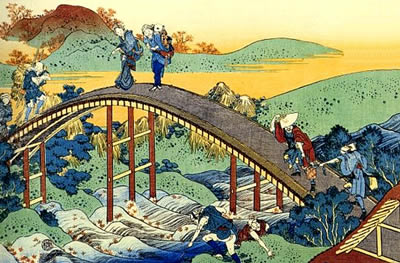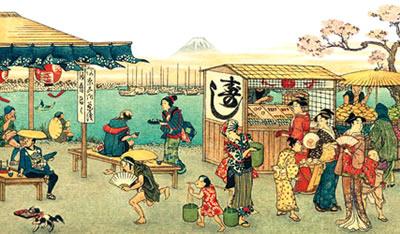World History
The Edo period in Japanese dates between 1600 and 1867. It denotes the government of the Tokugawa Shogunate from Edo. The shogunate was officially established in 1603 with the victory of Tokugawa Ieyasu over supporters of Toyotomi Hideyori in the Battle of Sekigahara (1600). The Tokugawa shoguns ruled Japan for more than 250 years with iron fists and tight discipline.
Ieyasu had centralized control over the entire country with his strategic power sharing arrangement between daimyo (feudal lords) and samurai (warriors). Daimyos were ordered to be present every second year in Edo to give an account of their assigned work.
Tokugawa Ieyasu promoted economic development through foreign trade. He established trading relations with China and the Dutch East India Company (Indonesia/ Batavia). While Osaka and Kyoto became emerging centers for trade and handicraft production, his capital Edo became the center for supply of food, construction, and consumer items.
To ensure its control, the shogunate banned all Japanese people from travel abroad in 1633. Japan thus was isolated except for limited commercial contact with the Dutch in the port of Nagasaki. All Western books were banned in Japan.
Despite Japan’s cultural isolation from the rest of the world, new indigenous art forms such as Kabuki theater and ukiyo-e, woodblock prints and paintings of the emerging urban popular culture, gained increasing popularity. Intellectually the most important state philosophy during the Edo period was Neo-Confucianism. Neo-Confucianism stressed the importance of morals, education, and hierarchical order in the government.
A rigid class system also took shape during the Edo period with samurai at the top, followed by the peasants, artisans, and merchants. Below them were outcasts (burakumin) or pariahs or those who were deemed impure. Neo-Confucianism contributed to the development of kokugaku (national learning) that stressed the study of Japanese history.

In 1720, with the lifting of the ban on Western literature, some Japanese began studying Western sciences and technologies, rangaku (Dutch studies). The fields that drew most interest were related to medicine, astronomy, natural sciences, art, geography, languages, as well as physical sciences including mechanical and electrical engineering.
External pressure on Japan grew toward the end of the 18th century. The Russians tried to establish a trade link with Japan to export their Russian goods, particularly vodka and wine. Other European nations also became interested.
Finally the United States forced Japan to open to the West when Commodore Matthew Perry sailed into Edo Bay with a flotilla of warships. Meanwhile, anti-Tokugawa sentiments had been growing that demanded the restoration of imperial power.
In 1867–68, the Tokugawa government collapse was partly due to foreign threat and to tensions that had been growing against a political and social system that had outlived its usefulness. The shogunate surrendered power in 1867 to Emperor Meiji, who began the Meiji Restoration in 1868.
- Neo-confucianism In Japan
Neo-Confucianism in Japan Neo-Confucianism was the revival and reinterpretation of the thoughts and principles of the ancient Chinese philosopher Confucius (551–479 b.c.e.) in China in the 11th century. Neo-Confucianism was used as state policy...
- Battle Of Sekigahara
Battle of Sekigahara The Battle of Sekigahara was fought between the forces of Tokugawa Ieyasu and those of his opponents. His decisive victory ensured his appointment as shogun of Japan and the establishment of the Tokugawa Shogunate that ruled Japan...
- Tokugawa Hidetada - Japanese Ruler
The second shogun of the Tokugawa family, Hidetada lived in his powerful father’s shadow until the latter’s death in 1616. He was Tokugawa Ieyasu’s third son; his two older brothers had died, making him Ieyasu’s successor....
- Tokugawa Ieyasu - Japanese Ruler
Tokugawa Ieyasu was granted by the Japanese emperor, the title of shogun in 1603; his family was to rule Japan until 1867. In 1605, his son, Tokugawa Hidetada, officially took the office of the shogun, but Ieyasu remained the ruler from behind the scenes...
- History Of Japan
History of Japan. This is a brief history of the Asian nation of Japan. It gives very little attention to most of Japanese history and instead focuses on the last 250 years. I have been in Japan twice but it was only to change planes. I hope to really...
World History
Edo Period in Japan
 |
| Edo Period in Japan |
The Edo period in Japanese dates between 1600 and 1867. It denotes the government of the Tokugawa Shogunate from Edo. The shogunate was officially established in 1603 with the victory of Tokugawa Ieyasu over supporters of Toyotomi Hideyori in the Battle of Sekigahara (1600). The Tokugawa shoguns ruled Japan for more than 250 years with iron fists and tight discipline.
Ieyasu had centralized control over the entire country with his strategic power sharing arrangement between daimyo (feudal lords) and samurai (warriors). Daimyos were ordered to be present every second year in Edo to give an account of their assigned work.
Tokugawa Ieyasu promoted economic development through foreign trade. He established trading relations with China and the Dutch East India Company (Indonesia/ Batavia). While Osaka and Kyoto became emerging centers for trade and handicraft production, his capital Edo became the center for supply of food, construction, and consumer items.
  |   |
To ensure its control, the shogunate banned all Japanese people from travel abroad in 1633. Japan thus was isolated except for limited commercial contact with the Dutch in the port of Nagasaki. All Western books were banned in Japan.
Despite Japan’s cultural isolation from the rest of the world, new indigenous art forms such as Kabuki theater and ukiyo-e, woodblock prints and paintings of the emerging urban popular culture, gained increasing popularity. Intellectually the most important state philosophy during the Edo period was Neo-Confucianism. Neo-Confucianism stressed the importance of morals, education, and hierarchical order in the government.
A rigid class system also took shape during the Edo period with samurai at the top, followed by the peasants, artisans, and merchants. Below them were outcasts (burakumin) or pariahs or those who were deemed impure. Neo-Confucianism contributed to the development of kokugaku (national learning) that stressed the study of Japanese history.

In 1720, with the lifting of the ban on Western literature, some Japanese began studying Western sciences and technologies, rangaku (Dutch studies). The fields that drew most interest were related to medicine, astronomy, natural sciences, art, geography, languages, as well as physical sciences including mechanical and electrical engineering.
External pressure on Japan grew toward the end of the 18th century. The Russians tried to establish a trade link with Japan to export their Russian goods, particularly vodka and wine. Other European nations also became interested.
Finally the United States forced Japan to open to the West when Commodore Matthew Perry sailed into Edo Bay with a flotilla of warships. Meanwhile, anti-Tokugawa sentiments had been growing that demanded the restoration of imperial power.
In 1867–68, the Tokugawa government collapse was partly due to foreign threat and to tensions that had been growing against a political and social system that had outlived its usefulness. The shogunate surrendered power in 1867 to Emperor Meiji, who began the Meiji Restoration in 1868.
- Neo-confucianism In Japan
Neo-Confucianism in Japan Neo-Confucianism was the revival and reinterpretation of the thoughts and principles of the ancient Chinese philosopher Confucius (551–479 b.c.e.) in China in the 11th century. Neo-Confucianism was used as state policy...
- Battle Of Sekigahara
Battle of Sekigahara The Battle of Sekigahara was fought between the forces of Tokugawa Ieyasu and those of his opponents. His decisive victory ensured his appointment as shogun of Japan and the establishment of the Tokugawa Shogunate that ruled Japan...
- Tokugawa Hidetada - Japanese Ruler
The second shogun of the Tokugawa family, Hidetada lived in his powerful father’s shadow until the latter’s death in 1616. He was Tokugawa Ieyasu’s third son; his two older brothers had died, making him Ieyasu’s successor....
- Tokugawa Ieyasu - Japanese Ruler
Tokugawa Ieyasu was granted by the Japanese emperor, the title of shogun in 1603; his family was to rule Japan until 1867. In 1605, his son, Tokugawa Hidetada, officially took the office of the shogun, but Ieyasu remained the ruler from behind the scenes...
- History Of Japan
History of Japan. This is a brief history of the Asian nation of Japan. It gives very little attention to most of Japanese history and instead focuses on the last 250 years. I have been in Japan twice but it was only to change planes. I hope to really...
